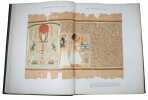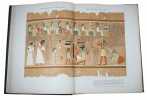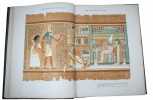"THE BOOK OF THE DEAD + E. A. WALLIS BUDGE.
The Book of the Dead. Facsimile of the Papyrus of Ani in the British Museum. Printed by Order of the Trustees. Second Edition. + The Book of the Dead. The Papyrus of Ani in the British Museum. The Egyptian Text with Interlinear Transliteration and Tra... - [THE SPLENDID FACSIMILE OF PAPYRUS ANI]
British Museum, 1894-95. Folio & 4to. Uncut in two contemporary half morocco bindings with gilt titles to spines. Folio volume: capitals with significant wear. Slight wear to outer hinges and edges of boards. Water stain to bottom of boards, slightly affecting the first five leaves. Internally clean. VII + 37 colored double-page lithographed plates. Text volume: five raised bands and gilt lines to spine. Upper edge of leaves gilt. Spine slightly rubbed, with some wear to capitals. Corners with significant loss of leather. Library stamps to inside of front board, front free endpaper, title page and contents page. Internally clean. CLV, 377 pp.
Reference : 62684
Second edition of the plate volume together with the first edition of the text (as it is supposed to be), being the first collected edition of the magnificent British Museum's facsimile of the Papyrus of Ani. The first edition of the plate-volume appeared alone, without the text, in 1890, and in 1894, a second edition of the plate-volume was issued to accompany the first edition of the text. Thus, a uniform set of the entire work originally belonging together will be made up of a second edition of the plate-volume together with the first edition of the text-volume. Produced around 1250 BCE, the lavishly illustrated papyrus of Ani remains one of the most splendid examples of the Book of the Dead. Egyptians compiled an individualized book for certain people upon their death, called the Book of Going Forth by Day, more commonly Book of the Dead, typically containing declarations and spells to help the deceased in the afterlife. The Papyrus of Ani, which is now in the British Museum, is the manuscript compiled for the Theban scribe. ""The scroll was discovered in Luxor in 1888 by Egyptians trading in illegal antiquities. It was acquired by E.A. Wallis Budge... Shortly after Budge first saw the papyrus, Egyptian police arrested several antiquities dealers and sealed up their houses, one of which contained the objects Budge had purchased from the dealers. Budge distracted the guards by offering them a meal while locals tunnelled under the house's walls to retrieve the objects, including the Papyrus of Ani. Stored in several custom tin boxes, the papyrus and other objects Budge had acquired were then smuggled to the principal librarian at the British Museum. Budge was afterward paid a 150GBP ""gratuity"" from the British Treasury on behalf of the British Museum for acquiring the papyrus.""
Bookseller's contact details
Herman H. J. Lynge & Son
William Schneider
Silkegade 11
1113 Copenhagen
Denmark
+45 33 155 335
Payment mode
Sale conditions
All items may be returned for a full refund for any reason within 14 days of receipt.
 Write to the booksellers
Write to the booksellers








